warning light SKODA SUPERB 2008 2.G / (B6/3T) Workshop Manual
[x] Cancel search | Manufacturer: SKODA, Model Year: 2008, Model line: SUPERB, Model: SKODA SUPERB 2008 2.G / (B6/3T)Pages: 272, PDF Size: 18.25 MB
Page 73 of 272
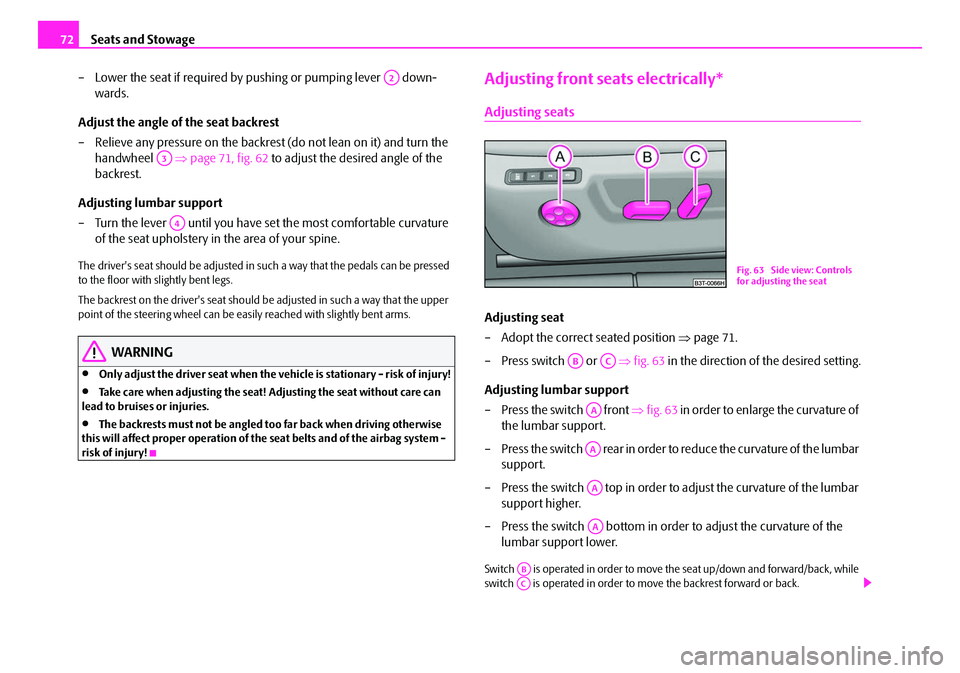
Seats and Stowage
72
– Lower the seat if required by pushing or pumping lever down-wards.
Adjust the angle of the seat backrest
– Relieve any pressure on the backrest (do not lean on it) and turn the handwheel ⇒page 71, fig. 62 to adjust the desired angle of the
backrest.
Adjusting lumbar support
– Turn the lever until you have set the most comfortable curvature of the seat upholstery in the area of your spine.
The driver's seat should be adjusted in such a way that the pedals can be pressed
to the floor with slightly bent legs.
The backrest on the driver's seat should be adjusted in such a way that the upper
point of the steering wheel can be easi ly reached with slightly bent arms.
WARNING
•Only adjust the driver seat when the ve hicle is stationary - risk of injury!
•Take care when adjusting the seat! Adjusting the seat without care can
lead to bruises or injuries.
•The backrests must not be angled too far back when driving otherwise
this will affect proper operation of th e seat belts and of the airbag system -
risk of injury!
Adjusting front seats electrically*
Adjusting seats
Adjusting seat
– Adopt the correct seated position ⇒page 71.
– Press switch or ⇒fig. 63 in the direction of the desired setting.
Adjusting lumbar support
– Press the switch front ⇒fig. 63 in order to enlarge the curvature of
the lumbar support.
– Press the switch rear in order to reduce the curvature of the lumbar support.
– Press the switch top in order to adjust the curvature of the lumbar support higher.
– Press the switch bottom in orde r to adjust the curvature of the
lumbar support lower.
Switch is operated in order to move the seat up/down and forward/back, while
switch is operated in order to move the backrest forward or back.
A2
A3
A4
Fig. 63 Side view: Controls
for adjusting the seat
ABAC
AA
AA
AA
AA
ABAC
NKO B6 20.book Page 72 Wednesday, March 26, 2008 3:15 PM
Page 77 of 272

Seats and Stowage
76
– Press the locking button in the direction of arrow ⇒page 75,
fig. 67 , press simultaneously the locking button into the opening
using a flat screwdriver with a width of maximum 5 mm and pull out
the head restraint.
– To re-insert the head restraint, push it down into the backrest of the seat far enough until you hear the locking button engage.
WARNING
•The head restraints must be correctly adjusted in order to offer effective
protection for the occupants in the event of an accident.
•Do not drive under any circumstance with removed head restraints - risk
of injury!
•If the rear seats are occupied, the rear head restraint must not be in the
lower position.
Rear seats
Folding the seat backrest forwards
The luggage compartment can be increased in size by folding forwards
the rear backrests.
Folding the rear backrests forward
– Before folding the rear backrests forward, you must adapt the position of the front seats in such a way that they are not damaged by the
folded rear backrests.
9)
– Unlock the rear backrests by pressing the unlocking handle ⇒fig. 68 and fold completely forwards.
Fold the rear backrests back into position
– Install the head restraint in the slightly lifted rear seat backrest.
– Place the rear lateral seat belt behind the edge of the side trim
panel ⇒fig. 69 .
– Then push the seat backrest back into the upright position until the securing knob clicks into place - check by pulling on the rear seat
backrest.
AA
AB
Fig. 68 Unlock the seat back-
rest
9)If the front seats are too far back, we recommend that you have the rear head restraints re-
moved before the seat backrests are folded forward. Store the removed head restraints in
such a way that they cannot be damaged or soiled. Please refer to the guidelines ⇒page 78.
Fig. 69 Lock the seat back-
rest
AA
AC
NKO B6 20.book Page 76 Wednesday, March 26, 2008 3:15 PM
Page 78 of 272
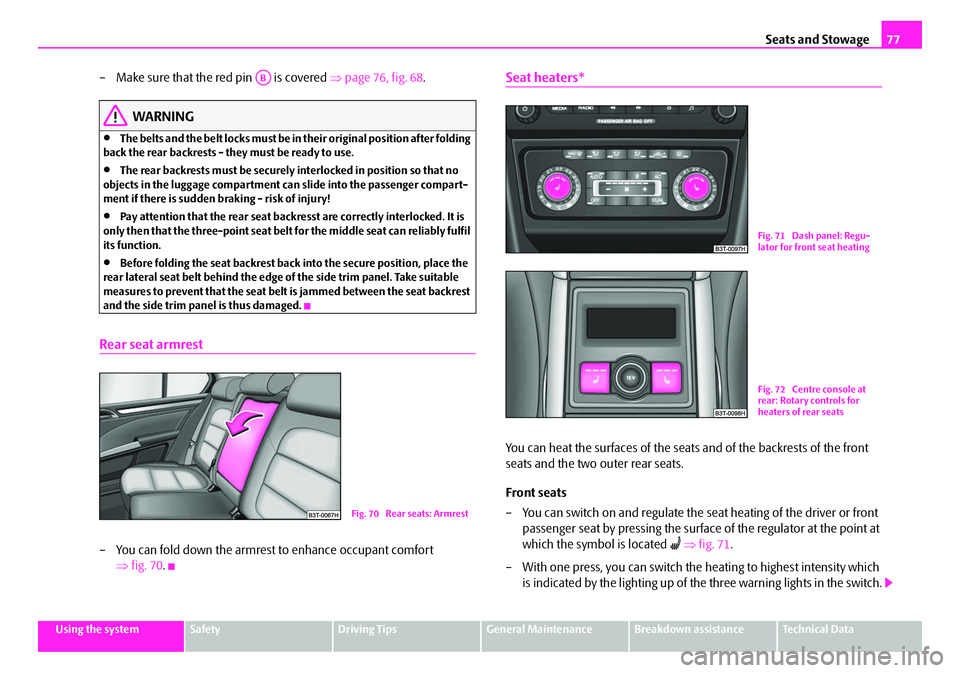
Seats and Stowage77
Using the systemSafetyDriving TipsGeneral MaintenanceBreakdown assistanceTechnical Data
– Make sure that the red pin is covered ⇒page 76, fig. 68 .
WARNING
•The belts and the belt locks must be in their original position after folding
back the rear backrests - they must be ready to use.
•The rear backrests must be securely interlocked in position so that no
objects in the luggage compartment ca n slide into the passenger compart-
ment if there is sudden braking - risk of injury!
•Pay attention that the rear seat backresst are correctly interlocked. It is
only then that the three-point seat belt for the middle seat can reliably fulfil
its function.
•Before folding the seat backrest back into the secure position, place the
rear lateral seat belt behind the edge of the side trim panel. Take suitable
measures to prevent that the seat belt is jammed between the seat backrest
and the side trim panel is thus damaged.
Rear seat armrest
– You can fold down the armrest to enhance occupant comfort ⇒fig. 70 .
Seat heaters*
You can heat the surfaces of the seat s and of the backrests of the front
seats and the two outer rear seats.
Front seats
– You can switch on and regulate the seat heating of the driver or front
passenger seat by pressing the surfac e of the regulator at the point at
which the symbol is located
⇒ fig. 71 .
– With one press, you can switch the heating to highest intensity which
is indicated by the lighting up of the three warning lights in the switch.
AB
Fig. 70 Rear seats: Armrest
Fig. 71 Dash panel: Regu-
lator for front seat heating
Fig. 72 Centre console at
rear: Rotary controls for
heaters of rear seats
NKO B6 20.book Page 77 Wednesday, March 26, 2008 3:15 PM
Page 79 of 272
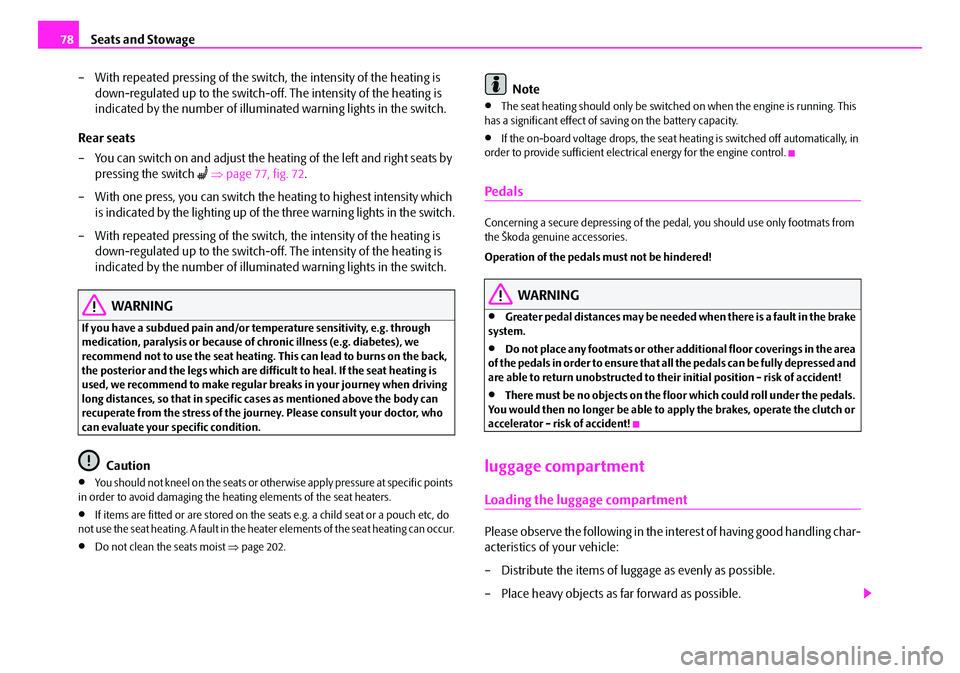
Seats and Stowage
78
– With repeated pressing of the switch, the intensity of the heating is down-regulated up to the switch-off. The intensity of the heating is
indicated by the number of illuminated warning lights in the switch.
Rear seats
– You can switch on and adjust the he ating of the left and right seats by
pressing the switch
⇒ page 77, fig. 72.
– With one press, you can switch the heating to highest intensity which is indicated by the lighting up of th e three warning lights in the switch.
– With repeated pressing of the switch, the intensity of the heating is down-regulated up to the switch-off. The intensity of the heating is
indicated by the number of illuminated warning lights in the switch.
WARNING
If you have a subdued pain and/or temperature sensitivity, e.g. through
medication, paralysis or because of chronic illness (e.g. diabetes), we
recommend not to use the seat heating. This can lead to burns on the back,
the posterior and the legs which are diff icult to heal. If the seat heating is
used, we recommend to make regular br eaks in your journey when driving
long distances, so that in specific cases as mentioned above the body can
recuperate from the stress of the journey. Please consult your doctor, who
can evaluate your specific condition.
Caution
•You should not kneel on the seats or otherwise apply pressure at specific points
in order to avoid damaging the heating elements of the seat heaters.
•If items are fitted or are stored on the se ats e.g. a child seat or a pouch etc, do
not use the seat heating. A fault in the heat er elements of the seat heating can occur.
•Do not clean the seats moist ⇒page 202.
Note
•The seat heating should only be switched on when the engine is running. This
has a significant effect of sa ving on the battery capacity.
•If the on-board voltage drops, the seat heating is switched off automatically, in
order to provide sufficient electrical energy for the engine control.
Pedals
Concerning a secure depressi ng of the pedal, you should use only footmats from
the Škoda genuine accessories.
Operation of the pedals must not be hindered!
WARNING
•Greater pedal distances may be needed when there is a fault in the brake
system.
•Do not place any footmats or other additional floor coverings in the area
of the pedals in order to ensure that all the pedals can be fully depressed and
are able to return unobstructed to thei r initial position - risk of accident!
•There must be no objects on the floor which could roll under the pedals.
You would then no longer be able to apply the brakes, operate the clutch or
accelerator - risk of accident!
luggage compartment
Loading the luggage compartment
Please observe the following in the inte rest of having good handling char-
acteristics of your vehicle:
– Distribute the items of luggage as evenly as possible.
– Place heavy objects as far forward as possible.
NKO B6 20.book Page 78 Wednesday, March 26, 2008 3:15 PM
Page 80 of 272
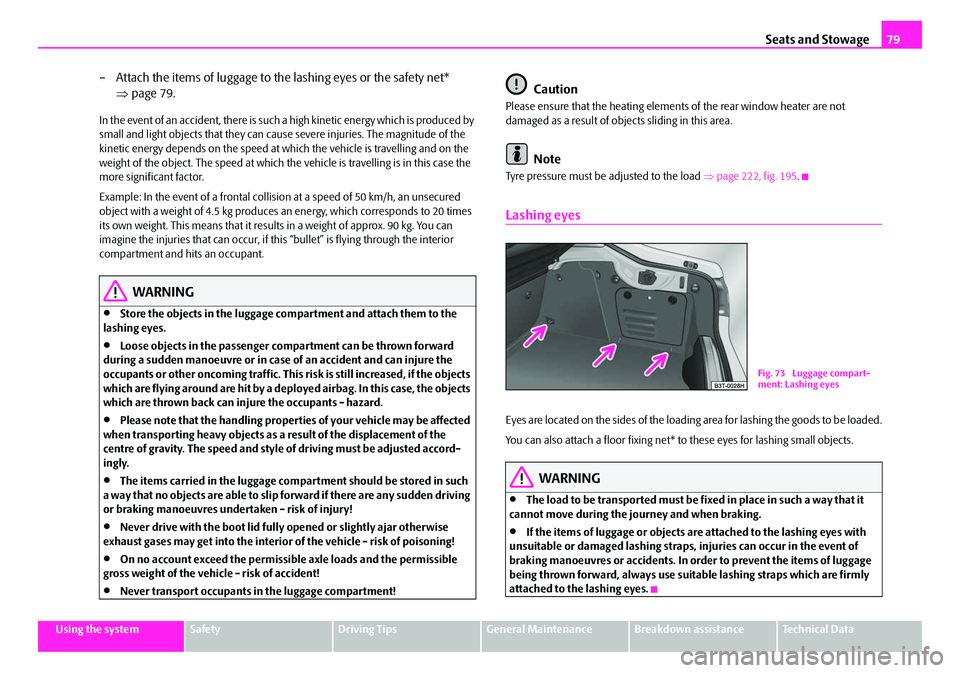
Seats and Stowage79
Using the systemSafetyDriving TipsGeneral MaintenanceBreakdown assistanceTechnical Data
– Attach the items of luggage to the lashing eyes or the safety net*
⇒page 79.
In the event of an accident, there is such a high kinetic energy which is produced by
small and light objects that they can caus e severe injuries. The magnitude of the
kinetic energy depends on the speed at wh ich the vehicle is travelling and on the
weight of the object. The speed at which the vehicle is travelling is in this case the
more significant factor.
Example: In the event of a frontal collis ion at a speed of 50 km/h, an unsecured
object with a weight of 4.5 kg produces an energy, which corresponds to 20 times
its own weight. This means that it results in a weight of approx. 90 kg. You can
imagine the injuries that can occur, if this “bullet” is flying through the interior
compartment and hits an occupant.
WARNING
•Store the objects in the luggage comp artment and attach them to the
lashing eyes.
•Loose objects in the passenger compartment can be thrown forward
during a sudden manoeuvre or in case of an accident and can injure the
occupants or other oncoming traffic. This risk is still increased, if the objects
which are flying around are hit by a depl oyed airbag. In this case, the objects
which are thrown back can injure the occupants - hazard.
•Please note that the handling properti es of your vehicle may be affected
when transporting heavy objects as a result of the displacement of the
centre of gravity. The speed and style of driving must be adjusted accord-
ingly.
•The items carried in the luggage compar tment should be stored in such
a way that no objects are able to slip forward if there are any sudden driving
or braking manoeuvres undertaken - risk of injury!
•Never drive with the boot lid fully opened or slightly ajar otherwise
exhaust gases may get into the interior of the vehicle - risk of poisoning!
•On no account exceed the permissi ble axle loads and the permissible
gross weight of the vehi cle - risk of accident!
•Never transport occupants in the luggage compartment!
Caution
Please ensure that the heating elements of the rear window heater are not
damaged as a result of objects sliding in this area.
Note
Tyre pressure must be adjusted to the load ⇒page 222, fig. 195 .
Lashing eyes
Eyes are located on the sides of the loading area for lashing the goods to be loaded.
You can also attach a floor fixing net* to these eyes for lashing small objects.
WARNING
•The load to be transported must be fixed in place in such a way that it
cannot move during the journey and when braking.
•If the items of luggage or objects ar e attached to the lashing eyes with
unsuitable or damaged lashing straps, injuries can occur in the event of
braking manoeuvres or accidents. In order to prevent the items of luggage
being thrown forward, always use suit able lashing straps which are firmly
attached to the lashing eyes.
Fig. 73 Luggage compart-
ment: Lashing eyes
NKO B6 20.book Page 79 Wednesday, March 26, 2008 3:15 PM
Page 82 of 272
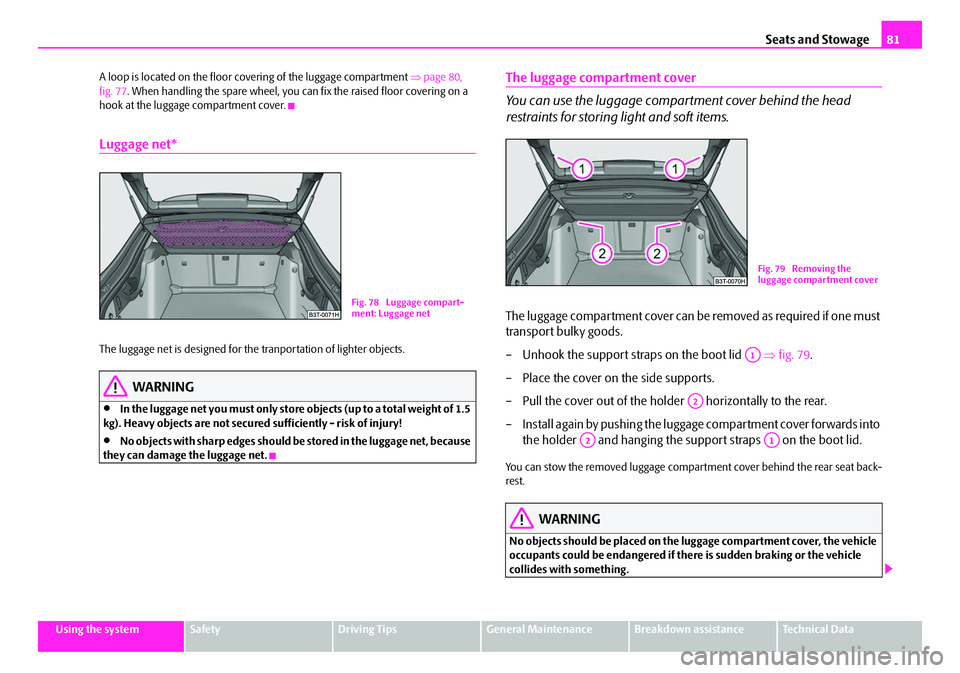
Seats and Stowage81
Using the systemSafetyDriving TipsGeneral MaintenanceBreakdown assistanceTechnical Data
A loop is located on the floor covering of the luggage compartment
⇒page 80,
fig. 77 . When handling the spare wheel, you ca n fix the raised floor covering on a
hook at the luggage compartment cover.
Luggage net*
The luggage net is designed for the tranportation of lighter objects.
WARNING
•In the luggage net you must only store objects (up to a total weight of 1.5
kg). Heavy objects are not secured sufficiently - risk of injury!
•No objects with sharp edges should be stored in the luggage net, because
they can damage the luggage net.
The luggage compartment cover
You can use the luggage compar tment cover behind the head
restraints for storing light and soft items.
The luggage compartment cover can be removed as required if one must
transport bulky goods.
– Unhook the support straps on the boot lid ⇒fig. 79 .
– Place the cover on the side supports.
– Pull the cover out of the holder horizontally to the rear.
– Install again by pushing the luggage compartment cover forwards into the holder and hanging the suppo rt straps on the boot lid.
You can stow the removed luggage compartment cover behind the rear seat back-
rest.
WARNING
No objects should be placed on the luggage compartment cover, the vehicle
occupants could be endangered if there is sudden braking or the vehicle
collides with something.
Fig. 78 Luggage compart-
ment: Luggage net
Fig. 79 Removing the
luggage compartment cover
A1
A2
A2A1
NKO B6 20.book Page 81 Wednesday, March 26, 2008 3:15 PM
Page 87 of 272

Seats and Stowage
86
Removing ashtray insert
– Open the ashtray ⇒page 89, fig. 94 .
– Grasp the ashtray insert at the point ⇒page 85, fig. 88 and take it
out in direction of arrow.
Insert ashtray insert
– Insert the ashtray vertically downwards.
WARNING
Never lay flammable objects in the ashtray basin - risk of fire!
Rear ashtray*
Removing ashtray insert
– Open the ashtray ⇒page 91, fig. 101 .
– Grasp the insert at the points marked with the arrows ⇒fig. 89 and
take it out.
Insert ashtray insert
– Insert the ashtray insert into the mount and press it in.
WARNING
Never lay flammable objects in the ashtray basin - risk of fire!
Cigarette lighter*, power sockets
Cigarette lighter
You can also use the socket on th e cigarette lighter for other elec-
trical appliances.
Using the cigarette lighter
– Press the button of the lighter ⇒fig. 89 or ⇒page 85, fig. 88.
– Wait until the button jumps forward.
– Remove the cigarette lighter immediately and use it.
– Insert the cigarette lighter again into the socket.
Using the socket
– Remove the cover.
– Connect the plug of the electr ical appliance to the socket.
The 12 volt power socket can also be used to supply power to electrical accessories
with a power uptake up to 180 watts.
WARNING
•Take care when using the cigarette lighter! Not paying proper attention
or incorrect use the cigarette lighter in an uncontrolled manner may result in
burns.
•The cigarette lighter and the power so cket also operates when the igni-
tion is switched off or the ignition key withdrawn. You should therefore
never leave children unattended in the vehicle.
AA
Fig. 89 Centre console: Rear
ashtray
AAAB
NKO B6 20.book Page 86 Wednesday, March 26, 2008 3:15 PM
Page 96 of 272

Seats and Stowage95
Using the systemSafetyDriving TipsGeneral MaintenanceBreakdown assistanceTechnical Data
Clothes hooks*
A clothes hook is located above the rear doors ⇒fig. 109 .
WARNING
•Ensure that any clothes hanging from the hooks do not impair your
vision to the rear.
•Use the hooks for hanging only light items of clothing and ensure that
there are no heavy or sharp- edged objects in the pockets.
•Do not use clothes hangers for hanging up items of clothing otherwise
this will interfere with the protection offered by the head airbag*.
Fig. 109 Rear door: Clothes
hooks
NKO B6 20.book Page 95 Wednesday, March 26, 2008 3:15 PM
Page 98 of 272

The air conditioning system97
Using the systemSafetyDriving TipsGeneral MaintenanceBreakdown assistanceTechnical Data
Using the system
Fig. 110 Climatic: Control elements
Setting temperature
– Turn the control dial ⇒fig. 110 to the right in order to increase the
temperature.
– Turn the control dial to the left in order to increase the tempera- ture.
Controlling blower
– Turn the blower switch into one of the positions, 1 to 4, in order to switch the blower on.
– Turn the blower switch into position 0 in order to switch the blower off.
– Pressing button - causes the recirculating air system ⇒page 99 to be switched on. Control for air distribution
– You can adjust the direction of the air flow
⇒page 99 using air distri-
bution regulator .
Switching cooling on and off
– Press the button ⇒ fig. 110. The warning light lights up in the
button.
– When you again press the switch , the cooling system is switched off. The warning light in the button goes out.
Rear window heater
– Press button . Further information ⇒ page 63.
Auxiliary heating
– Press the button in order to directly switch on/off the auxiliary heating (auxiliary heating and ventilation. Further information
⇒page 106.
The set temperature will be automatically maintained other than when the
control dial is on the extreme right or extreme left position:
•Extreme right position - full heating;
•Extreme left position - full cooling;
•The blower should aways be on to prevent the windows from misting up.
Note
•The whole heat output will be needed to unfrost the windscreen and side
windows. No warm air will be fed to the footwell. This can lead to restriction of the
heating comfort.
•The used air streams out through the air removal openings in the luggage
compartment.
•If the cooling system has not been switched on for a lengthy period, odours may
be produced at the evaporator because of deposits. Switch the cooling system on
AA
AA
AB
AB
A4
AC
ACA1
AC
A2
A3
NKO B6 20.book Page 97 Wednesday, March 26, 2008 3:15 PM
Page 100 of 272

The air conditioning system99
Using the systemSafetyDriving TipsGeneral MaintenanceBreakdown assistanceTechnical Data
Recirculated air mode
In recirculated air mode air is sucked out of the interior of the vehicle
and then fed back into the interior.
Recirculated air mode prevents polluted air outside the vehicle from
getting into the vehicle, for example when driving through a tunnel or
when standing in a traffic jam.
Switching recirculated air mode on
– Press the button ⇒page 97, fig. 110 the warning light lights
up in the button.
Switching recirculated air mode off
– Press again the button - the warning light in the button goes out.
The recirculated air mode is switched off au tomatically if the air distribution control
is in position ⇒ page 97, fig. 110 . You can also switch recirculated air mode
on again from this setting by repeatedly pressing button .
WARNING
You should not leave recirculated air mode on over a longer period of time,
as “stale” air may result in fatigue in the driver and occupants, divert your
attention and also cause the windows to mist up. The risk of having an acci-
dent increases. Switch recirculated air mode off as soon as the windows
begin misting up.
Air outlet vents
Fig. 111 Air vents at the front
Fig. 112 Air vents at the rear
Open air outlet vents
– Turn the rotary knob to position
.
Close air outlet vents
– Turn the rotary knob to position 0.
A4
AC
NKO B6 20.book Page 99 Wednesday, March 26, 2008 3:15 PM